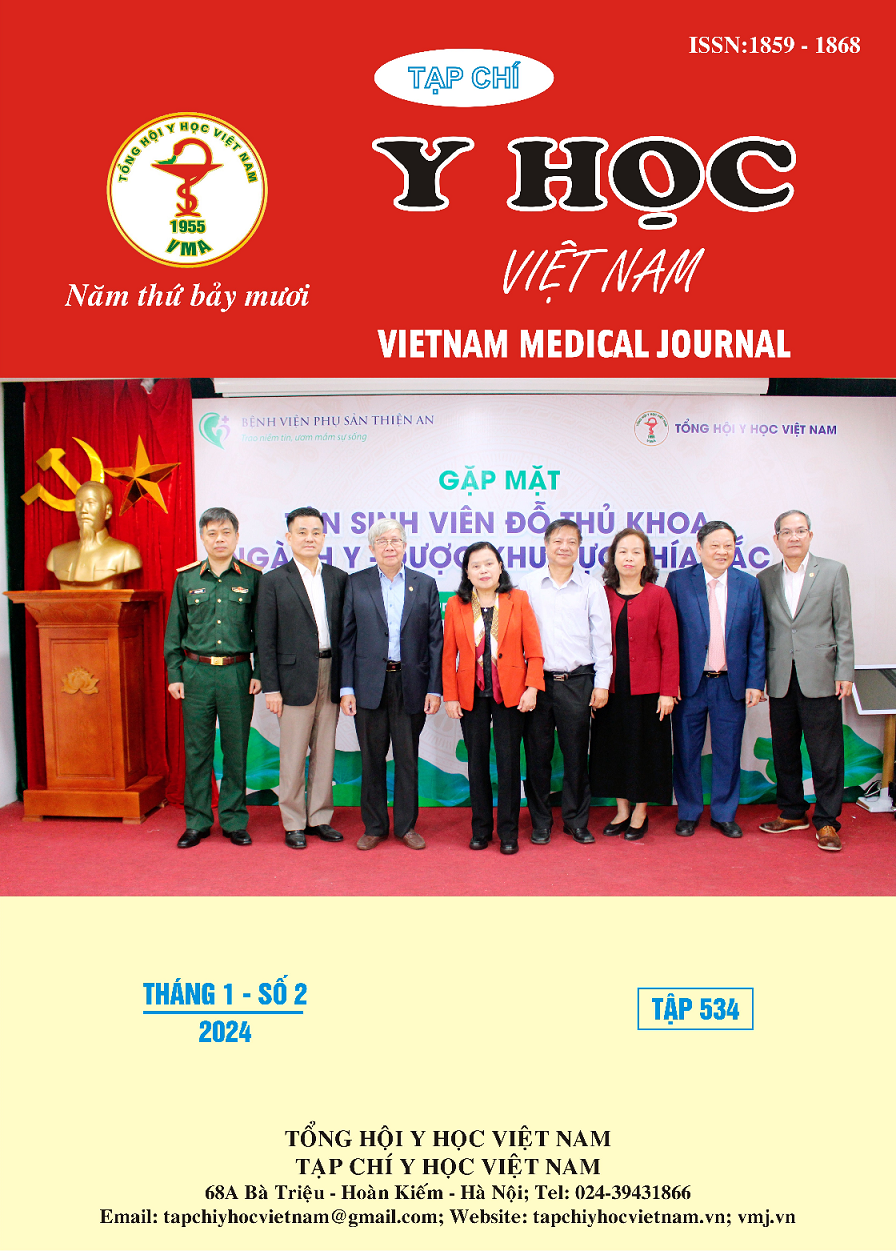ĐẶC ĐIỂM LÂM SÀNG, HÌNH ẢNH NỘI SOI VÀ KẾT QUẢ ĐIỀU TRỊ QUA NỘI SOI Ở BỆNH NHÂN CHẢY MÁU TIÊU HÓA DO LOÉT DẠ DÀY-TÁ TRÀNG
Nội dung chính của bài viết
Tóm tắt
Mục tiêu: Đánh giá kết quả cầm máu bằng kẹp clip trong điều trị chảy máu tiêu hóa (CMTH) do loét dạ dày tá tràng (DDTT). Đối tượng và phương pháp: Tiến cứu, 135 bệnh nhân có CMTH do loét DDTT được kẹp clip qua nội soi. Tất cả các bệnh nhân đều được điều trị nội trú, khám lâm sàng, cận lâm sàng và nội soi đường tiêu hóa trên. Các thông số cần đánh: Lâm sàng, nội soi và kết quả cầm máu qua nội soi. Kết quả: Hiệu quả cầm máu đạt: 135/135 bệnh nhân (100%). Kết luận: Điều trị kết hợp kẹp clip + tiêm adrenalin cho hiệu quả tốt hơn so điều trị kẹp clip đơn thuần.
Chi tiết bài viết
Tài liệu tham khảo
1. Bộ Y tế - Bệnh viện Bạch Mai (2011). Hướng dẫn chẩn đoán và điều trị bệnh nội khoa. Nhà xuất bản Y học.
2. Hội khoa học tiêu hóa Việt Nam (2009). Khuyến cáo xử trí xuất huyết tiêu hóa trên cấp tính không do tăng áp lực tĩnh mạch cửa. Tạp chí khoa học tiêu hóa Việt Nam, tập IV, số 17, trang: 1178-1192.
3. Trần Việt Tú, Thái Bá Có (2005). Nhận xét hiệu quả của 2 dung dịch Nacl 3,6%-Adrenalin1/10.000 và polidocanol trong điều trị chảy máu tiêu hóa do loét dạ dày - tá tràng qua nội soi. Y học thực hành số 4, trang: 23-25.
4. Barkun A, Sabbah S, Enns R, et al (2004). The Canadian Registry on Nonvariceal Upper Gastrointestinal Bleeding and Endoscopy (RUGBE): Endoscopic hemostasis and proton pump inhibition are associated with improved outcomes in a real-life setting. Am J Gastroenterol; 99: 1238-1246.
5. Forrest JA, Finlayson ND, Shearman DJ (1974). Endoscopy in gastrointestinal bleeding. Lancet; 2: 394-397.
6. Guo SB, Gong AX, Leng J, et al. Application of endoscopic hemoclips for nonvariceal bleeding in the upper gastrointestinal tract. World J Gastroenterol 2009; 15(34): 4322-4326.
7. Lewis JD, Bilker WB, Brensinger C, et al (2002). Hospitalization and mortality rates from peptic ulcer disease and GI bleeding in the 1990s: Relationship to sales of nonsteroidal anti-inflammatory drugs and acid suppression medications. Am J Gastroenterol; 97: 2540-2549.
8. Lim CH, Vani D, Shah SG, et al (2006). The outcome of suspected upper gastrointestinal bleeding with 24 hour access to upper gastrointestinal endoscopy: A prospective cohort study. Endoscopy; 38: 581-585.
2. Hội khoa học tiêu hóa Việt Nam (2009). Khuyến cáo xử trí xuất huyết tiêu hóa trên cấp tính không do tăng áp lực tĩnh mạch cửa. Tạp chí khoa học tiêu hóa Việt Nam, tập IV, số 17, trang: 1178-1192.
3. Trần Việt Tú, Thái Bá Có (2005). Nhận xét hiệu quả của 2 dung dịch Nacl 3,6%-Adrenalin1/10.000 và polidocanol trong điều trị chảy máu tiêu hóa do loét dạ dày - tá tràng qua nội soi. Y học thực hành số 4, trang: 23-25.
4. Barkun A, Sabbah S, Enns R, et al (2004). The Canadian Registry on Nonvariceal Upper Gastrointestinal Bleeding and Endoscopy (RUGBE): Endoscopic hemostasis and proton pump inhibition are associated with improved outcomes in a real-life setting. Am J Gastroenterol; 99: 1238-1246.
5. Forrest JA, Finlayson ND, Shearman DJ (1974). Endoscopy in gastrointestinal bleeding. Lancet; 2: 394-397.
6. Guo SB, Gong AX, Leng J, et al. Application of endoscopic hemoclips for nonvariceal bleeding in the upper gastrointestinal tract. World J Gastroenterol 2009; 15(34): 4322-4326.
7. Lewis JD, Bilker WB, Brensinger C, et al (2002). Hospitalization and mortality rates from peptic ulcer disease and GI bleeding in the 1990s: Relationship to sales of nonsteroidal anti-inflammatory drugs and acid suppression medications. Am J Gastroenterol; 97: 2540-2549.
8. Lim CH, Vani D, Shah SG, et al (2006). The outcome of suspected upper gastrointestinal bleeding with 24 hour access to upper gastrointestinal endoscopy: A prospective cohort study. Endoscopy; 38: 581-585.


